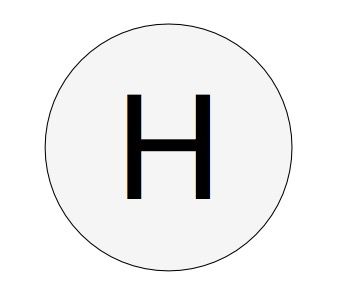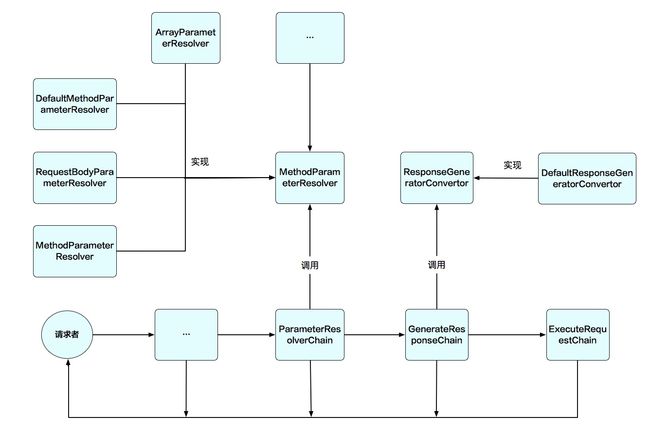概述
当我们提到java调用http请求时,我们想到的是HttpClient或是内置的HttpUrlConnention。
然后会写下如下一串的代码访问http接口:
HttpClient client = new HttpClient();
client.getHostConfiguration().setProxy("127.0.0.1", 8888);
client.getHostConfiguration().setHost("bl.ocks.org", 80, "http");
GetMethod getMethod = new GetMethod("/mbostock/raw/4090846/us-congress-113.json");
client.executeMethod(getMethod);
//打印服务器返回的状态
System.out.println(getMethod.getStatusLine().getStatusCode());
if(getMethod.getStatusLine().getStatusCode() == 200){
//打印结果页面
String response = new String(getMethod.getResponseBodyAsString().getBytes("8859_1"));
//打印返回的信息
System.out.println(response);
}
getMethod.releaseConnection();
可是我们是不是有一种更优雅的方式呢?类似于MyBatis,通过一定的配置,然后在需要请求http接口的时候只需要调用一个接口函数便可以完成上述代码的工作。
这就是HttpFetch的初衷,让http请求的调用更优雅。
下载
git clone https://github.com/youzan/httpfetch.git
对象
- ParameterResolver:api参数解析类,自带的可以对数组、bean、简单类型等参数进行解析并封装成Get、Post、Form等类型请求的参数。也可以通过Url注解灵活定义api接口的请求地址。
- Convertor:返回数据封装类,自带的仅支持简单类型和JSON类型的数据进行封装。通过扩展可以实现更多的转换方式。
- Chain: 责任链模式,一层层对请求进行加工和处理。里面比较重要的是ParameterResolverChain、GenerateResponseChain和ExecuteRequestChain。ParameterResolverChain负责对参数进行处理,GenerateResponseChain负责对返回结果进行处理,ExecuteRequestChain负责最后的请求发送。
- ResourceReader: 配置信息读取类,负责对各组件单元的读取并最终传给HttpApiConfiguration类。
- HttpApiConfiguration: 负责对ResourceReader读取后的配置信息进行封装,然后将配置信息传给HttpApiService类。
- HttpApiService: 负责最后的代理类生成和缓存;
框架
-
初始化过程
初始化过程可以选择spring和xml两种。spring的方式直接将生成的代理类注册到BeanDefinitionRegistry(可见HttpApiClassPathBeanDefinitionScanner源码),xml方式可以在没有spring组件的情况下独立运行(见单测MbostockApiUseXmlTest)。两种方式都可以完成Chain、ParamterResolver和Convertor注册。
-
请求处理流程
请求者发起请求时,会通过配置的各个Chain单元,一步一步的处理和封装参数并发送最终的Http请求,最后将返回的值进行封装。
使用
Maven
com.github.youzan
http-fetch
1.1.6
非spring调用
1.创建http-api.xml配置文件:
2.编写MbostockApi接口类:
package com.github.nezha.httpfetch.mbostock.api;
import com.github.nezha.httpfetch.HttpApi;
import com.github.nezha.httpfetch.Header;
import com.github.nezha.httpfetch.mbostock.vo.UsCongressResponseVo;
/**
* Created by daiqiang on 17/3/14.
*/
public interface MbostockApi {
@HttpApi(timeout = 1000, headers = {@Header(key="user-agent", value = "Mozilla/5.0 (Macintosh; Intel Mac OS X 10_11_6) AppleWebKit/537.36 (KHTML, like Gecko) Chrome/58.0.3029.110 Safari/537.36")})
UsCongressResponseVo getUsCongress();
}
3.编写测试类:
SourceReader xmlReader = new XmlReader(Arrays.asList("httpapi.xml"));
HttpApiConfiguration configuration = new HttpApiConfiguration();
configuration.setSourceReaders(Arrays.asList(xmlReader));
configuration.init();
HttpApiService service = new HttpApiService(configuration);
service.init();
MbostockApi mbostockApi = service.getOrCreateService(MbostockApi.class);
UsCongressResponseVo responseVo = mbostockApi.getUsCongress();
System.out.println("type=="+responseVo.getType());
System.out.println("arcs->size=="+responseVo.getArcs().size());
System.out.println("objects->districts->bbox->size=="+responseVo.getObjects().getDistricts().getBbox().size());
System.out.println("objects->districts->type=="+responseVo.getObjects().getDistricts().getType());
System.out.println("objects->districts->geometries->size=="+responseVo.getObjects().getDistricts().getGeometries().size());
System.out.println("transform->scale=="+responseVo.getTransform().getScale());
System.out.println("transform->translate=="+responseVo.getTransform().getTranslate());
以上就是非spring方式的调用
spring方式的调用
1.创建application-httpapi.xml文件:
2.编写MbostockApi接口类:
package com.github.nezha.httpfetch.mbostock.api;
import com.github.nezha.httpfetch.HttpApi;
import com.github.nezha.httpfetch.Header;
import com.github.nezha.httpfetch.mbostock.vo.UsCongressResponseVo;
/**
* Created by daiqiang on 17/3/14.
*/
public interface MbostockApi {
@HttpApi(timeout = 1000, headers = {@Header(key="user-agent", value = "Mozilla/5.0 (Macintosh; Intel Mac OS X 10_11_6) AppleWebKit/537.36 (KHTML, like Gecko) Chrome/58.0.3029.110 Safari/537.36")})
UsCongressResponseVo getUsCongress();
}
3.编写测试类:
public class MbostockApiTest extends BaseTest {
@Autowired
private MbostockApi mbostockApi;
@Test
public void test(){
UsCongressResponseVo responseVo = mbostockApi.getUsCongress();
System.out.println("type=="+responseVo.getType());
System.out.println("arcs->size=="+responseVo.getArcs().size());
System.out.println("objects->districts->bbox->size=="+responseVo.getObjects().getDistricts().getBbox().size());
System.out.println("objects->districts->type=="+responseVo.getObjects().getDistricts().getType());
System.out.println("objects->districts->geometries->size=="+responseVo.getObjects().getDistricts().getGeometries().size());
System.out.println("transform->scale=="+responseVo.getTransform().getScale());
System.out.println("transform->translate=="+responseVo.getTransform().getTranslate());
}
}
URL映射
url的映射使用了三种方式:
1.使用xml进行配置:
2.使用注解方式:
package com.github.nezha.httpfetch.bookworm.api;
import com.github.nezha.httpfetch.Header;
import com.github.nezha.httpfetch.HttpApi;
import com.github.nezha.httpfetch.resolver.RequestBody;
import java.util.Map;
/**
* Created by daiqiang on 17/6/16.
*/
public interface AlarmJobApi {
@HttpApi(method = "POST", headers = @Header(url = "http://alert.s.qima-inc.com/api/v1/alert", key = "Content-type", value = "application/json"), timeout = 2000)
String alert(@RequestBody Map param);
}
3.使用参数方式传入:
@HttpApi(timeout = 1000, headers = {@Header(key="user-agent", value = "Mozilla/5.0 (Macintosh; Intel Mac OS X 10_11_6) AppleWebKit/537.36 (KHTML, like Gecko) Chrome/58.0.3029.110 Safari/537.36")})
UsCongressResponseVo getUsCongress(@URL String url);
测试类:
public void test_url_param(){
String url = "https://bl.ocks.org/mbostock/raw/4090846/us-congress-113.json";
UsCongressResponseVo responseVo = mbostockApi.getUsCongress(url);
System.out.println("type=="+responseVo.getType());
System.out.println("arcs->size=="+responseVo.getArcs().size());
System.out.println("objects->districts->bbox->size=="+responseVo.getObjects().getDistricts().getBbox().size());
System.out.println("objects->districts->type=="+responseVo.getObjects().getDistricts().getType());
System.out.println("objects->districts->geometries->size=="+responseVo.getObjects().getDistricts().getGeometries().size());
System.out.println("transform->scale=="+responseVo.getTransform().getScale());
System.out.println("transform->translate=="+responseVo.getTransform().getTranslate());
}
参数封装
1.Get请求参数:
使用QueryParam注解标记,并填写参数的名称
@HttpApi(timeout = 2000, url = "http://bookworm365.com/uploadImage")
@BookWormApi
UploadFileResponseVo uploadFile(@QueryParam("name") String name,
@QueryParam("n_value") String nValue);
2.Post请求参数:
使用PostParam注解标记,并填写参数的名称
Map audit(@PostParam("advertisementId") Integer advertisementId);
3.Form请求参数:
使用FormParam注解标记,并填写参数的名称
@HttpApi(timeout = 2000, url = "http://bookworm365.com/uploadImage")
@BookWormApi
UploadFileResponseVo uploadFile(@FormParam("file") File file,
@QueryParam("name") String name,
@QueryParam("n_value") String nValue);
4.BeanParam注解使用:
当我们传递一个bean做为参数,但是希望对这个bean进行解析然后作为http请求参数时,我们可以使用BeanParam注解。
@HttpApi(timeout = 2000, url = "http://bookworm365.com/uploadImage")
@BookWormApi
UploadFileResponseVo uploadFile(@BeanParam @QueryParam UploadFileRequestVo requestVo);
package com.github.nezha.httpfetch.bookworm.vo;
import com.alibaba.fastjson.annotation.JSONField;
import java.io.File;
public class UploadFileRequestVo {
@JSONField(name = "file")
private File file;
private String name;
@JSONField(name="n_value")
private String nValue;
public File getFile() {return file;}
public void setFile(File file) {this.file = file;}
public String getName() {return name;}
public void setName(String name) {this.name = name;}
public String getnValue() {return nValue;}
public void setnValue(String nValue) {this.nValue = nValue;}
}
http请求最终解析结果如下:
http://bookworm365.com/uploadImage?file=XXX&name=XXX&n_value=XXX
5.RequestBody注解使用:
当你需要传递消息体给服务器是,可以通过该注解。
例如我们想要传递一个application\json的请求:
@HttpApi(method = "POST",timeout = 2000,headers = {@Header(key = "Content-type", value = "application/json;charset=UTF-8")})
@WechatApi
WechatBaseResponseVo add(@RequestBody AddCustomAudiencesRequestVo requestVo);
结果封装
结果封装默认支持简单类型和JSON两种:
1.简单类型,如果返回值是String、int、long等,api的返回对象可以直接指定对应类:
@HttpApi(timeout = 2000, url = "http://bookworm365.com/checkHeader")
@BookWormApi
String checkHeader();
2.JSON,如果返回值是一个json字符串,可以直接编写对应的bean作为返回类,内部使用fastjson进行反序列化:
@HttpApi(timeout = 1000, headers = {@Header(key="user-agent", value = "Mozilla/5.0 (Macintosh; Intel Mac OS X 10_11_6) AppleWebKit/537.36 (KHTML, like Gecko) Chrome/58.0.3029.110 Safari/537.36")})
UsCongressResponseVo getUsCongress();
package com.github.nezha.httpfetch.mbostock.vo;
import com.alibaba.fastjson.annotation.JSONField;
import java.util.List;
public class UsCongressResponseVo {
@JSONField(name="type")
private String type;
@JSONField(name="objects")
private ObjectsVo objects;
@JSONField(name="arcs")
private List>> arcs;
@JSONField(name="transform")
private TransformVo transform;
public String getType() {return type;}
public void setType(String type) {this.type = type;}
public ObjectsVo getObjects() {return objects;}
public void setObjects(ObjectsVo objects) {this.objects = objects;}
public List>> getArcs() {return arcs;}
public void setArcs(List>> arcs) {this.arcs = arcs;}
public TransformVo getTransform() {return transform;}
public void setTransform(TransformVo transform) {this.transform = transform;}
}
package com.github.nezha.httpfetch.mbostock.vo;
import com.alibaba.fastjson.annotation.JSONField;
import com.github.nezha.httpfetch.BaseTest;
public class ObjectsVo {
@JSONField(name="districts")
private DistrictsVo districts;
public DistrictsVo getDistricts() {return districts;}
public void setDistricts(DistrictsVo districts) {this.districts = districts;}
}
另外返回的类还支持泛型。
@HttpApi(timeout = 1000, headers = {@Header(key="user-agent", value = "Mozilla/5.0 (Macintosh; Intel Mac OS X 10_11_6) AppleWebKit/537.36 (KHTML, like Gecko) Chrome/58.0.3029.110 Safari/537.36")})
UsCongressResponseVo getUsCongress();


